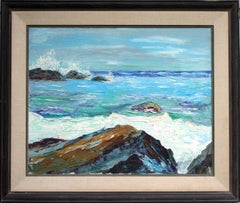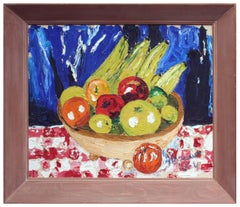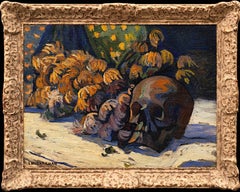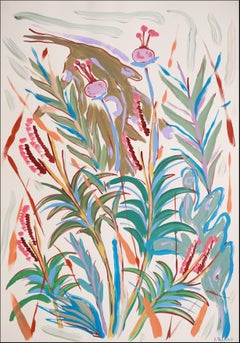T. Brown Art
to
1
1
1
Overall Width
to
Overall Height
to
2
2
1
2
1
2
2
1
1
1
2
8,779
2,809
1,642
1,313
1
2
Artist: T. Brown
Carmel by the Sea "Near Point" 1969 Seascape T. Brown Monterey
By T. Brown
Located in Soquel, CA
Carmel by the Sea "Near Point" 1969 Seascape
Substantial modernist period seascape painting by Monterey artist T. Brown. Displayed in a linen lined giltwood frame. Heavy and bold i...
Category
1960s Other Art Style T. Brown Art
Materials
Canvas, Oil
Mid Century Modern Fauvist Basket of Fruit Still-Life in Primary Colors
By T. Brown
Located in Soquel, CA
Substantial and period mid century modernist impasto still life of a basket of fruit upon a table by Monterey, California artist T. Brown (American, 20th Century). This bold still-li...
Category
1960s Fauvist T. Brown Art
Materials
Board, Oil
$1,200 Sale Price
20% Off
Related Items
Antique Fauvist "Still Life with Flowers and Skull" Louis Mathieu Verdilhan
Located in SANTA FE, NM
Antique Fauvist Vanitas "Still Life with Flowers and Skull"
Louis Mathieu Verdilhan (Provence, France, 1875-1928)
Circa 1910
Oil on canvas on ...
Category
Early 1900s Fauvist T. Brown Art
Materials
Canvas, Wood, Oil
Tropical Garden, Expressionist Green Plants, Jurassic, Botanical Painting, Paper
Located in Barcelona, ES
"Tropical Garden" is an illustration style painting of tropical jungle plants. Vibrant greens, expressionist gestures, and intricate textures come together in this artwork to create...
Category
2010s Fauvist T. Brown Art
Materials
Acrylic, Watercolor, Paper
Red Cactus Flower
Located in Stockholm, SE
A fauvist still life painting of a red cactus flower by Agda Holst (1886-1976). Oil on panel, signed Agda Holst. Probably painted somewhere around 1912-1920 when she had returned to Sweden after her studies abroad. It is painted on a Swedish panel...
Category
Early 20th Century Fauvist T. Brown Art
Materials
Oil, Panel
Vase with Flowers, Painting by Charles Cobelle
By Charles Cobelle
Located in Long Island City, NY
Vase with Flowers
Charles Cobelle
French (1902–1994)
Date: circa 1960
Acrylic on Canvas, signed l.r.
Size: 10 x 8 in. (25.4 x 20.32 cm)
Category
1960s Fauvist T. Brown Art
Materials
Canvas, Acrylic
fruit still life original oil on canvas painting
By Lluis Mercader
Located in Barcelona, Barcelona
Lluís Mercader (Barcelona, 1898 - 1959) was a Spanish painter. Trained in Paris and Munich, he exhibited individually at the Dalmau Galleries in Barcelona (1925) and collectively ...
Category
1950s Fauvist T. Brown Art
Materials
Canvas, Oil
$321 Sale Price
46% Off
H 7.49 in W 9.45 in
Bizarre bouquet
Located in Oslo, NO
This vibrant artwork showcases an abundant bouquet of flowers, expertly arranged in a rustic, earth-toned vase. The composition bursts with a rich pal...
Category
2010s Fauvist T. Brown Art
Materials
Canvas, Oil
Still life flowers oil on canvas painting fauvist
By Jordi Curos
Located in Barcelona, Barcelona
Jordi Curós Ventura (1930-2007) - Still life
Oil on canvas.
Canvas measurements 35x27 cm.
Frameless.
Jordi Curós Ventura (Olot, Girona, March 4, 1930) is a Spanish painter.
He trai...
Category
1970s Fauvist T. Brown Art
Materials
Canvas, Oil
$298 Sale Price
37% Off
H 13.78 in W 10.63 in
1950's French Fauvist Signed Oil Red Roof Tops Pink Houses Scene
Located in Cirencester, Gloucestershire
The French Town
French School (Fauvist), mid 20th century
indistinctly signed lower front
oil painting on artists board, unframed
size: 15 x 18 inches
condition: very good
provenance: from a private collection in Paris
Superb mid 20th century French Fauvist...
Category
Mid-20th Century Fauvist T. Brown Art
Materials
Oil
Mid 20th Century French Oil on Board. 'The Blue Vase'.
Located in Cotignac, FR
French Mid 20th Century oil on board Fauvist still life, flowers in a vase in an interior scene, by Hyppolite Roger. The painting is signed bottom righ...
Category
Mid-20th Century Fauvist T. Brown Art
Materials
Board, Oil
$1,478 Sale Price
22% Off
H 20 in W 17 in D 1.5 in
Farmhouse
By George W. Drew
Located in Greenville, DE
George W. Drew 1875-1968. Excellent example of his work, housed in a period Louie XIV style frame measuring 20.5 x 24.5in. Painted in early to mid 20th century.
Category
Early 20th Century Realist T. Brown Art
Materials
Canvas, Oil
Still life with apples 1961. Canvas, oil, 50x70 cm
Located in Riga, LV
Still life with apples
1961. Canvas, oil, 50x70 cm
Published at book Biruta baumane on 78 page
"Still Life with Apples" is a stylized still life pain...
Category
1960s Fauvist T. Brown Art
Materials
Oil, Canvas
$4,578 Sale Price
20% Off
H 19.69 in W 27.56 in D 0.79 in
Deck of Foxhill
Located in Greenville, DE
Marine scene from the deck of a Maine estate (Foxhill). William Beebe considers himself a Creative Realist, using touches of impressionism to go beyond representation. This particula...
Category
20th Century American Impressionist T. Brown Art
Materials
Canvas, Oil
T. Brown art for sale on 1stDibs.
Find a wide variety of authentic T. Brown art available for sale on 1stDibs. You can also browse by medium to find art by T. Brown in oil paint, paint, board and more. Much of the original work by this artist or collective was created during the 1960s and is mostly associated with the Post-Impressionist style. Not every interior allows for large T. Brown art, so small editions measuring 29 inches across are available. Customers who are interested in this artist might also find the work of Marion Huse, Helen Enoch Gleiforst, and Chuck Fee Wong. T. Brown art prices can differ depending upon medium, time period and other attributes. On 1stDibs, the price for these items starts at $1,050 and tops out at $2,400, while the average work can sell for $1,725.
Artists Similar to T. Brown
Questions About T. Brown Art
- Is there a brown topaz?1 Answer1stDibs ExpertApril 5, 2022Yes, brown topaz stones are actually fairly common. The brown color in topaz is caused by imperfections in the crystal structure. These imperfections can also cause a variety of other hues. Find an assortment of brown topaz jewelry from the world’s top sellers on 1stDibs.
- Do brown diamonds sparkle?1 Answer1stDibs ExpertApril 5, 2022Yes, brown diamonds sparkle. The sparkle effect in a diamond is caused by light interacting with the cut of the diamond. The depth of the diamond can also affect the amount of sparkle. This is important because it’s the cut of the diamond that creates the sparkle, not the color. Shop a collection of brown diamonds from some of the world’s top sellers on 1stDibs.
- Who wears Thom Browne?1 Answer1stDibs ExpertFebruary 13, 2024Many celebrities wear Thom Browne. In recent years, the designer's apparel and accessories have been red carpet favorites. For example, Daniel Ricciardo, Trevor Noah, Pusha T, Alexander Skarsgard, Teyana Taylor, Bella Ramsey, Shai Gilgeous-Alexander, Janelle Monae, Sora Choi, Olivia Rodrigo and Jenna Ortega all wore Thom Browne to the 2023 Met Gala. On 1stDibs, shop a large collection of Thom Browne apparel and accessories.
- What is a fancy brown diamond?1 Answer1stDibs ExpertApril 5, 2022A brown diamond is also known as a champagne diamond or a chocolate diamond if the hue is deep enough. Chocolate diamonds are known for their distinctive color and coveted for their unique look. Shop a collection of brown, champagne and chocolate diamond jewelry on 1stDibs.
- Is Brown Jordan good quality?1 Answer1stDibs ExpertMarch 31, 2023Yes, many people consider Brown Jordan to be good quality. Furniture made by the brand usually features durable materials like wood and aluminum and quality craftsmanship. The outdoor furniture brand began to take shape in 1945, when Robert Brown, an industrial designer, and Hubert Jordan met in Pasadena, California, and began collaborating on their first design, a traditional wrought-iron breakfast set they called Morning Glory. Shop a variety of Brown Jordan furniture from some of the world’s top sellers on 1stDibs.
- 1stDibs ExpertAugust 26, 2024The best way to tell if a Thom Browne is real is to look at the labels. Because the brand's labels have differed over the years and may vary between different types of items, a good approach is to look for images of similar authentic pieces shared on trustworthy online resources. Look for any variations between logos, font size and spacing that may indicate your item is a knockoff. You may also wish to consult a knowledgeable expert for assistance with authentication. Shop a collection of Thom Browne apparel and accessories on 1stDibs.
- 1stDibs ExpertJanuary 10, 2025Opinions may differ as to what Steven Brown's most famous painting is. However, he is widely known for his colorful depictions of animals. Some of his most popular prints among collectors include Heather McCoo, Allan & Jackie McZoo, Forest Of Argyle, Home and Save the Ocean Families. Shop a diverse assortment of art on 1stDibs.
- Is Thom Browne a luxury brand?1 Answer1stDibs ExpertApril 5, 2024Yes, Thom Browne is a luxury brand. The British brand has a solid reputation for using fine materials and for employing expert tailoring and finishing techniques when producing its pieces. As a result, Thom Browne clothing and accessories can fetch the aspirational prices associated with luxury fashion. Explore a selection of Thom Browne apparel, bags, shoes and accessories on 1stDibs.
- 1stDibs ExpertMarch 3, 2023Brown Jordan chairs are made of a variety of materials. Specifics vary for each piece, but generally, the furniture maker uses wood, vinyl, woven resin wicker, aluminum, glass, stone, rope and UV-resistant fabrics to craft furniture. On 1stDibs, shop a collection of Brown Jordan furniture.
- 1stDibs ExpertJanuary 10, 2025Cecily Brown became famous for her large-scale paintings that depict erotic scenes from a feminist perspective. At her first solo exhibition in 1997, Charles Saatchi purchased one of her pieces, launching her into the spotlight. By 2000, she was posing for photoshoots for well-known publications like Vanity Fair. Find a variety of Cecily Brown art on 1stDibs.
- 1stDibs ExpertSeptember 9, 2024No one knows for sure how much the 7.46 brown diamond is worth. In early 2024, a French tourist discovered the 7.46-carat gemstone at Crater of Diamonds State Park in Arkansas. At the time, experts estimated that it may be worth between $40,000 and $130,000 once cleaned and polished. However, the actual value will not be known unless the finder chooses to make the results of a professional appraisal public. Explore a large selection of diamond jewelry on 1stDibs.
- 1stDibs ExpertNovember 14, 2023Yes, brown leather bags can go with virtually everything. Brown pairs well with other neutrals like beige, black and gray, and coordinates well with warm colors like orange, gold and red. In addition, brown can make an appealing contrast with cooler shades like blue, green and purple. Explore a large selection of brown leather bags from some of the world's top boutiques on 1stDibs.
- 1stDibs ExpertNovember 1, 2023Whether you should buy a Gucci belt in brown or black is a matter of personal preference. Some people believe black belts have a dressier appearance, while brown is considered more casual and is perhaps better suited to everyday wear. Both colors will pair well with a wide variety of other colors, giving you the freedom to mix and match the accessories with many pieces in your wardrobe. On 1stDibs, find a variety of Gucci belts.
- 1stDibs ExpertNovember 2, 2021The best color for decor and furniture to go with your brown leather couch will vary upon your personal preference. Earthy hues, warm and serene, will enhance the beauty of your brown leather couch – consider beige, bluish pink, orange or teal. Shop a collection of antique, vintage, and contemporary brown leather couches from some of the world’s top dealers on 1stDibs.
- 1stDibs ExpertOctober 19, 2021Many colors go well with brown leather furniture — it is a matter of preference. The different colors that pair well with brown leather furniture are white, black, brown, red, off-white, blue and many more. Shop for a variety of vintage and antique brown leather furniture on 1stDibs today.
- 1stDibs ExpertOctober 19, 2021Shades of blue go well with brown leather furniture. Even white or beige works well. Because they are frequently seen together in nature, colors like olive green, ocean blue, terra-cotta, and rusty red all combine well with brown. For a warm, inviting living room, use an earthy wall color and complement your brown sofa with neutral pillows or blankets. Find a collection of antique and vintage style brown leather furniture on 1stDibs today.
- 1stDibs ExpertFebruary 13, 2023Louis Vuitton stopped using brown boxes in 2016. At that time, the brand began packaging handbags and accessories in saffron yellow boxes with cobalt blue ribbons and handles. Shop a collection of Louis Vuitton from some of the world’s top sellers on 1stDibs.



